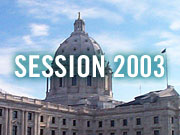Audio
Your Voice
| |||||||||||||||||||||||||||||||||||||||||||||||
Pawlenty tries for 'politics-free' aid distribution
May 1, 2003
Gov. Tim Pawlenty has released new guidelines for distributing aid payments to cities across Minnesota. Administration officials say the new local government aid formula eliminates historical inequities in state assistance and focuses exclusively on a city's needs and resources. But city representatives say the formula isn't the point. While the distribution of aid may change, they argue the governor is also slashing the total amount of aid across the board, leaving municipal officials with few options.
St. Paul, Minn. — The local government aid formula hasn't changed since 1993, and even then, large portions of it were based on historic funding levels dating back to the '70S.
State Revenue Commissioner Dan Salomone says the "grandfathering" of outdated aid payments leads to clear inequities. Salomone says the new formula is based solely on a new analysis of municipal data matching a city's real needs against its ability to pay.
"It requires no judgments about what cities do, no subjective judgments. We're not casting aspersions about whether cities are doing good things or bad things or spending too much or too little. It's a statistically-based method without any overriding political adjustments," he said.
Salomone says the formula considers such factors as the age of a city's housing stock and the number of traffic accidents per capita -- and rearranges aid payments according to where they're most needed.
Large urban centers generally see little change, while rural cities see some increases. Twin Cities suburbs, however, stand to lose -- in some cases -- all of their state aid. But local government advocates say the shifts in payments aren't the issue.
"No matter what formula you have, no matter how good it is, it doesn't matter if it's severely underfunded," responded Tim Flaherty, who represents the Coalition of Greater Minnesota Cities. He notes that Gov. Pawlenty has proposed slashing local government aid by more than 40 percent per year by 2005.
Flaherty says he hasn't identified any major objections to the new distribution formula. But he says the formula is irrelevant without the funding to flow through it.
"That's where they're going to have to lay off public safety personnel, police and fire. That's where the rub comes. That's where it really devastates many of our cities in greater Minnesota. It's the funding level," Flaherty said.
House Republicans have proposed restoring about 10 percent of the governor's cuts. But Taxes Committee Chair Ron Abrams, R-Minnetonka, says cities shouldn't expect to emerge from the state's budget crisis unharmed. Abrams says all levels of government will feel a crunch as lawmakers struggle to erase a $4.2 billion projected deficit.
"For the last two years the state government and a lot of other agencies have had to tighten their belt. And cities, by and large, have been left unscathed. And I think they ought to be asked to be part of the solution. I don't see anything wrong with it," he said.
Abrams says it's important to distinguish between the debate over how much to spend on LGA and the debate over how to distribute that amount. He says the administration's distribution plan is a vast improvement over current law, and he says the House will release its own recommendations later on Thursday.
With less than three weeks left in the regular legislative session, however, there's little time for restructuring the payments. Senate Democrats say they've no proposal of their own, but Taxes Committee Chair Larry Pogemiller, DFL-Minneapolis, says he's open to the debate. Pogemiller says he has no problem with eliminating the practice of grandfathering old aid payments into the current formula and removing limits on how much aid payments can increase from year to year.
"The governor wants to do it. I'm open to it. I'm open to reform. I told the governor two years ago I'm open to reform of the LGA formula. I think a formula that has that much money caught up in grandfathers and that much caught up in caps... it's not a working formula," according to Pogemiller.
Pogemiller, however, cautions that he hasn't had time to study the governor's recommendations. And he suggests the administration wants to focus too much on the distribution formula and ignore the critics who say cuts to overall funding are too drastic.
Senate DFLers would restore more than a quarter of the governor's funding reductions.
|
News Headlines
|
Related Subjects
|

